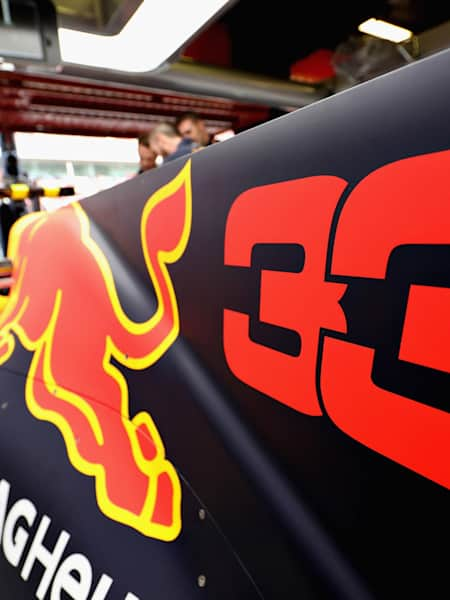Red Bull Motorsports
Is there something fishy about Ferrari's SF70H? If you look closely at the car, do you notice elements that could be inspired by aquatic creatures? Well it's not just you. According to Max Verstappen, it's due to the influence of the Ferrari design consultant Rory Byrne.
Byrne, who designed Michael Schumacher's championship winning cars at Benetton and Ferrari, is not only a car designer but also a Scuba-diving fanatic, and his work is often inspired by the streamlined sea creatures he sees while diving. Given that Verstappen has grown up in F1 circles, and that his father raced that same Benetton as Schumacher, he might be on to something.
Nature excels at creating aerodynamic shapes and aerodynamicists are not above appropriating a good idea. A couple of decades ago Mercedes-Benz brought the science of bionics – reverse-engineering biological methods and systems found in nature – into car design with their study of the boxfish and resulting Bionic concept car.
They may have been barking up the wrong tree, as more recent boxfish studies have suggested, but the basic premise is sound: nature has good ideas about design and won't sue if you pinch them.
Ferrari 156 sharknose
Ferrari's 156 F1 car debuted in 1961 and propelled driver Phil Hill to the world championship that season. Ferrari's first version of the car has two angled air intakes on the nose, which gave it a pointed appearance that looked a bit like a shark.
Red Bull Racing RB4 shark fin
Being massive, hydrodynamically-efficient apex predators, sharks tend to be popular with little boys who grow up to design all sorts of sports tech. Dorsal fins help with stability, and, if you stretch the definition, that's what they do on F1 cars.
The high rear wings of 2009–2016 sat in relatively clear air, but the newly reintroduced lower wings are less effective because they sit in a more turbulent airflow. The shark fins help to condition that airflow and get it flowing in a more linear fashion, which makes the rear wing work more efficiently. And 'shark fin' sounds way cooler than 'ironing board'.
Walrus-nosed Williams FW26
While it has no basis in actual facts, lots of people in F1 like to believe in the maxim that if it looks good, it'll drive good. Cars like the Williams FW26 tend to back up the claim, because the arrival of their aesthetically brutal walrus-nosed 2004 car saw Williams's fortunes take a nosedive.
Designed to maximise airflow under the nose to make best use of a new twin-keel chassis, the car featured a bulbous, stubby nose attached to the front wing with two tusk-like spars. It wasn't the most predictable car to drive though, and Williams ditched the walrus nose and went back to a conventional design before the end of the season – and Juan Pablo Montoya won the Brazilian Grand Prix in the season-ending pretty version.
The anteater clan of 2014
Obviously a nose is the most anthropomorphically-sensitive part of a racing car, and so there's any number of animals associated with them – though perhaps the greatest infamy came in 2014 when a new set of rules introduced with the best of intentions created some of the most pug-ugly cars ever to ever grace the championship.
Intended to make racing safer by reducing the risk of wheel-over and T-bone collisions, F1 went to a low-nose design in 2014. But a low nose restricts airflow under the car and a big chunk of aerodynamic performance comes from working that flow hard. Most teams therefore decided to create a nose with the minimum-allowable cross-section. This lead to all sorts of uncomplimentary names, cleanest of which was 'anteater nose'.
Super Aguri SA07 chicken
Look at a mid-2000s F1 car now and the bodywork looks horrendously complicated, with all manner of scoops, flips and chimneys popping up all over the place. Splitters in front of the sidepods came in all shapes and sizes, and Super Aguri's looked (if you really, really wanted it to) a little bit like a cockerel's comb. Their press release announcing an aero update for the Spanish Grand Prix made mention of an all-new chicken, which caused a fair amount of confusion in some quarters.
Honda RA108 elephant ears
From the same era as the Super Aguri chicken, Honda tested a set of top-mounted nose winglets in 2007, and raced them in 2008. Occasionally referred to as 'Dumbo Wings' the aerodynamic vanes on top of the nosecone were an alternative to the over-and-under front wing design that several other teams ran. They went away when F1 opted to mandate clean top surfaces, and today teams take care of their front end aerodynamic needs with tiered, multi-element front wing designs that look like the world's most optimistic razor.
The monkey seat
Definitely not based on bionics, the monkey seat on a modern F1 car is the name given to the small supplementary wing perched in the space below the rear wing and above the rear crash structure. With a lot of imagination, and the pressing need to give a small monkey a ride-along on a Formula One car, this is the place where they might sit.
It's difficult to say conclusively who created the monkey seat, as F1 cars have mounted all sorts of supplementary wings down the years, but it's been a staple of F1 in recent years as both a downforce generator in its own right and, latterly, a device to direct exhaust flow into useful areas.













